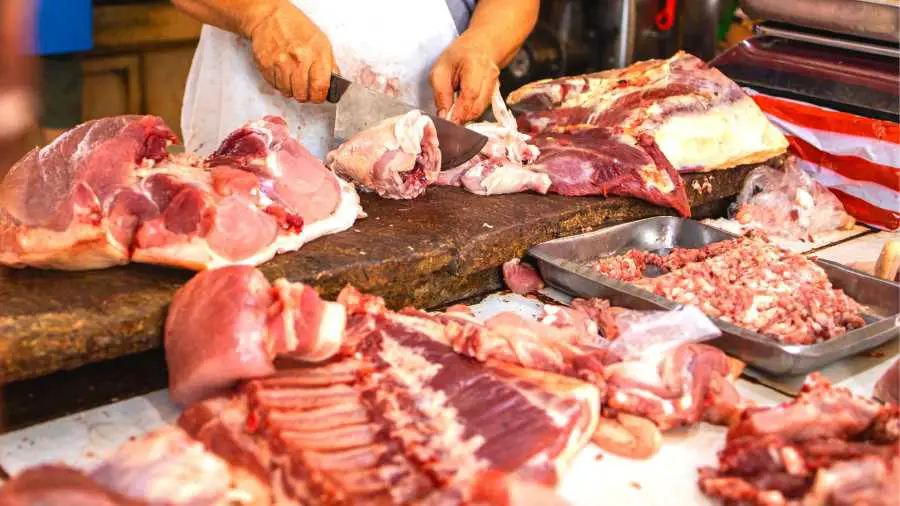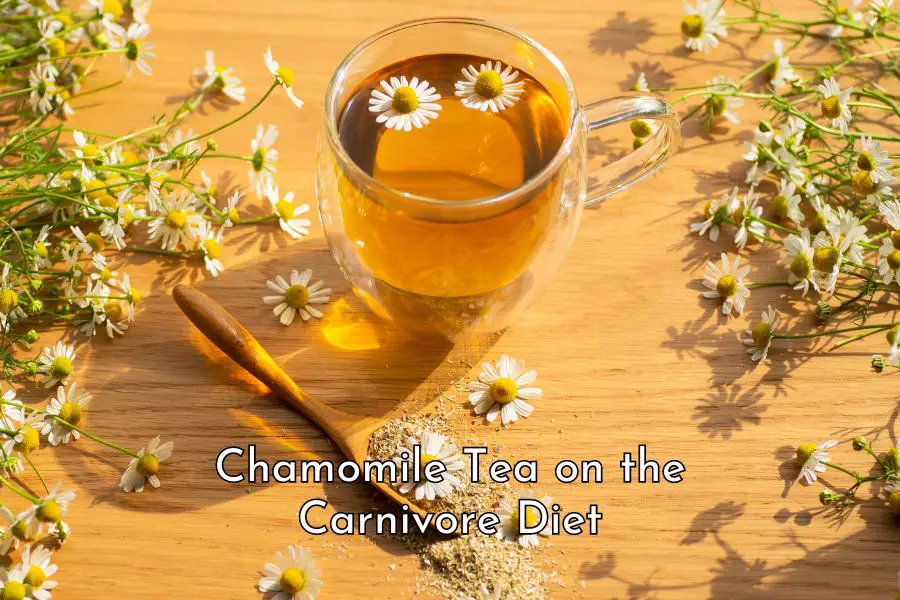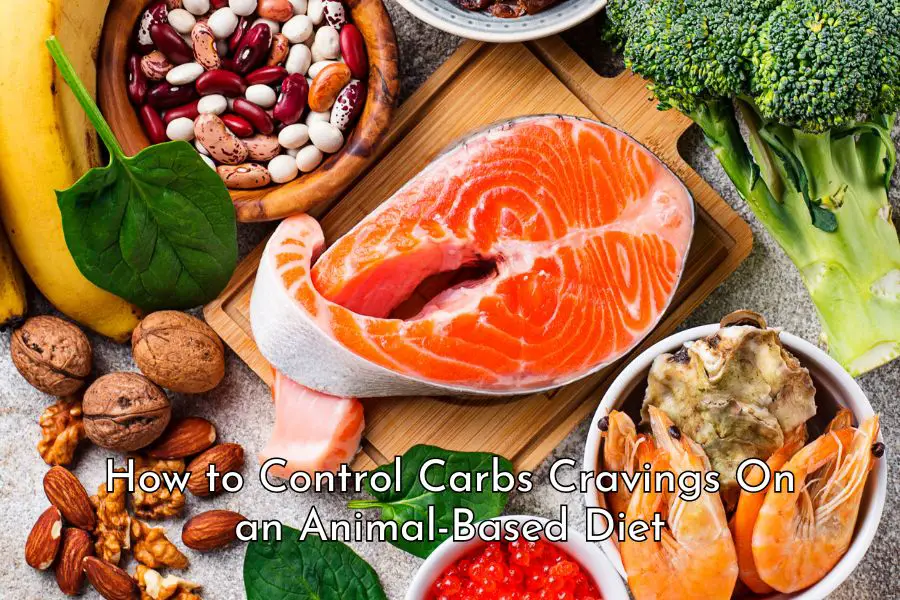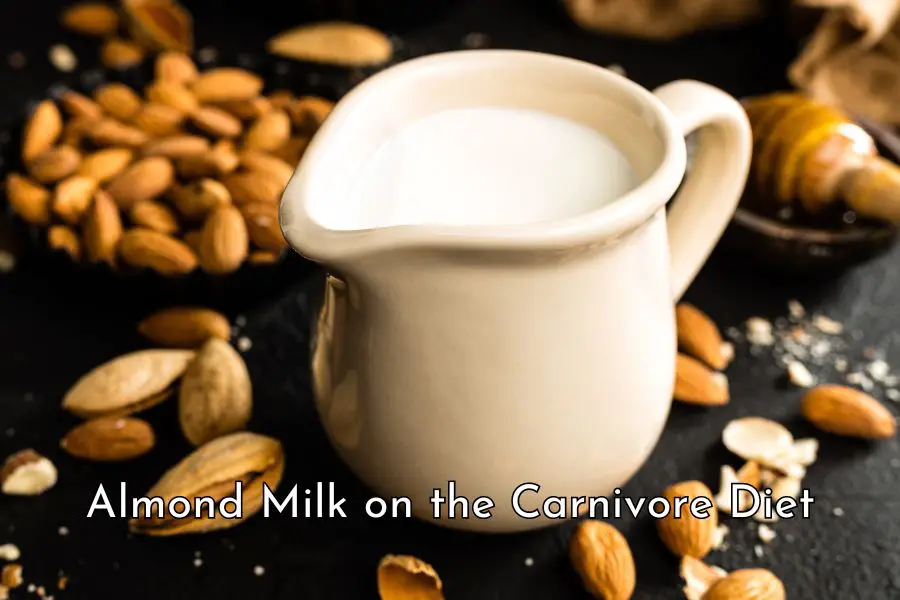People who have been on the carnivore diet for a considerable period of time seem to be unanimous in the view that the best meat to eat on the carnivore diet is beef.
In this post, we will look at the reasons why beef is indeed the best meat you can eat on the carnivore diet from evolutionary and nutritional perspectives.
Beef resembles the most what our ancestors used to eat
Our ancestors dined on megafaunas for millions of years and beef is the meat that most resembles what our ancestors used to eat.
The totality of evidence from human physiology and genetics, archeology, paleontology, and zoology all points to the fact that humans were hyper-carnivores instead of generalist omnivores. [1]
For about two million years, our ancestors dined on the meat of megafaunas like mammoths, elephants, mastodons, hippopotamuses, and rhinoceroses.
According to Doctor Miki Ben-Dor, this makes perfect sense from an economic point of view.
Large megafaunas provided our ancestors with the highest return per calorie spent.
Those mega herbivores have plenty of fat on them and they are heavy and slow. A few arrows could provide enough food for a large tribe for a few days.
On the other hand, smaller preys like birds, rabbits, or snakes are lean, a lot harder to catch, and provide a lower return per energy spent compared to large herbivores.
The return is even lower with regard to gathering fruits, nuts, seeds, and tubers which are also not available all year round.
The nutrient-dense and energy-dense meat of those large animals have been credited for the exponential growth in the human brain size from 650cc around 2.6 million years ago to about 1,500cc about 100,000 years ago. [2, 3]
Then, from about 20,000 years ago, the human brain size started to decline and that coincided with the advent of agriculture and the substantial increase in the consumption of plant-based food.
So, to return to our ancestral diet and to eat what the human body is meant to eat, it seems that beef is the best meat to eat nowadays because it resembles the most what our ancestors used to eat.
The meat of other large ruminants like bison, buffalo, yak, or elk are also great choices but it is harder to find.
Beef is nutritionally superior compared to other meat
In addition to being consistent with our ancestors’ diet, beef is also more nutritious compared to other meats like pork, chicken, and fish from conventional farming operations.
Beef, pork, chicken, and fish are all great sources of good quality proteins and essential vitamins and minerals.
However, there are two main differences in the fatty acid profile of beef and other ruminants and that of pork and poultry due to modern farming practices:
- Beef and other ruminant meat like lamb have a higher percentage of saturated fats and a lower percentage of polyunsaturated fats
- Beef and other ruminant meat have a favorably lower omega 6 to omega 3 ratio which is a lot closer to the ratio that our ancestors used to eat.
We will look at these two differences in more detail below.
Beef is high in saturated fat and low in polyunsaturated fat
As can be seen in the table below, beef fat is rich in saturated and monounsaturated fat and very low in polyunsaturated fat (PUFA).
In particular, only around 4% of beef fat is polyunsaturated fat compared to 14% to 21% in pork and chicken fat.
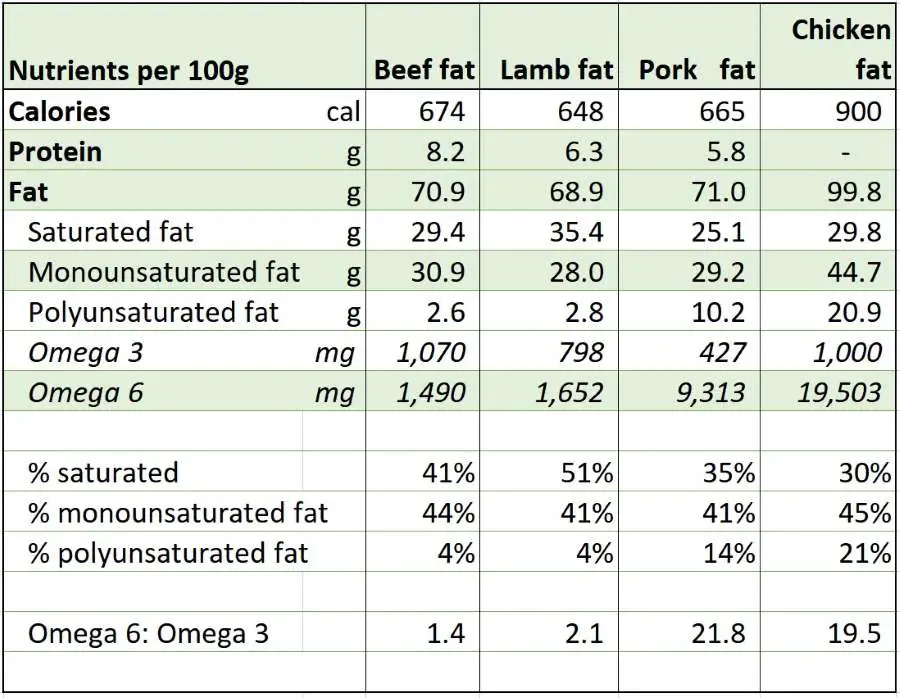
This difference between beef fat (and that of ruminants in general) and chicken and pork fat is due to the difference between their physiologies and how they are raised.
Cows and other ruminants have stomachs with multiple compartments that allow them to convert polyunsaturated fats into saturated fats. [4]
Pigs and poultry, on the other hand, are monogastric animals, i.e. they have a single stomach and are unable to convert polyunsaturated fats from their diet into saturated fats. [5]
As a result, if their diet is high in PUFAs, their fat will be high in PUFAs as well. And this is most certainly the case with factory farms where they are fed a high-PUFA diet consisting of soybean, corn oil, and industrial byproducts. [6]
Because humans are also monogastric animals, if we consume meat with fat high in PUFAs, it will end up in our fatty tissues as well.
Pigs and poultry are literally what they eat and so are humans.
Let’s have a look below at why a high PUFA intake is bad for your health.
Why PUFAs are bad for you?
PUFAs are fats with more than one unsaturated carbon bond (double bond) in the molecule and are liquid at room temperature.
Due to their unstable chemical structure, PUFAs are prone to damage from high-heat cooking, prolonged light exposure, and oxygen.
This is in contrast to saturated fats which are much less prone to damage thanks to their stable chemical structures.
Oxidized PUFAs are inflammatory and have been linked to many modern health problems.
In particular, PUFAs have been linked to many chronic inflammatory diseases such as nonalcoholic fatty liver disease, cardiovascular disease, obesity, inflammatory bowel disease, rheumatoid arthritis, Alzheimer’s disease, and even cancer. [7, 8, 9]
A randomized controlled trial called “Sydney Diet Heart Study” conducted from 1966 to 1973 involving 458 men with a recent coronary event found that “substituting dietary linoleic acid [omega-6] in place of saturated fats increased the rates of death from all causes, coronary heart disease, and cardiovascular disease“. [10]
In simple terms, based on this study, if you increase your PUFA intake, you are likely to die earlier.
This is why beef with its extremely low PUFA level has been considered one of the best meat to eat on the carnivore diet.
Beef has a more favorable omega 6 to omega 3 ratio
Beef also has a much more favorable omega 6 to omega 3 ratio which is very close to the ratio that our ancestors are thought to have consumed.
Our ancestors are thought to have consumed omega 6 and omega 3 in a ratio of approximately 1:1. [11]
The ratio in beef fat is between 1 and 2. For example, as shown in the above table, one beef fat sample has a ratio of 1.4. [12]
In contrast, pork and chicken’s omega-6 to omega-3 ratios are somewhere between 10 and 20. For example, as shown in the above table, pork and chicken fats have omega 6 to omega 3 ratios of 21.8 and 19.5 respectively. [13]
Most people today consume far more omega 6 relative to omega 3.
In the U.S., for example, the current intake data indicate that this ratio has blown up to approximately 10:1. It’s no wonder why most of the population has become so sick. [14]
Beef is generally better raised than pork and poultry
Cattle even in factory farms are generally better raised than pork and poultry. Better raised means healthier animals that are less likely to be treated with drugs which translates to better food quality for humans.
Cattle raised for beef still spend most of their lives outdoors and eat a diet relatively close to their natural diets.
They typically spend a large part of their lives, from 12 to 18 months, grazing on pasture.
They will then spend about 4 to 6 months at the feedlot where they are fed a grain-based diet to accelerate weight gain.
Even if they are fed a grain-based diet, this is still generally consistent with their natural diet because grains (e.g. rice, wheat, barley, millet, rye, oat, corn, and sorghum) are grass seeds after all.
Pigs and chickens, however, generally spend their entire lives in crowded sheds or cages and are fed a composite diet that is very different from their natural diets.
Pigs raised for meat in factory-farmed operations generally spend their entire lives in barren crates or concrete pens so small that they have no room to turn around. They do not have outdoor access. Sows spend their reproductive lives confined to a small gestation crate. [15]
These pigs are fed a grain-based diet consisting of corn, soybean, wheat, barley, oat, and added vitamins and minerals.
Because pigs are omnivores, a 100% plant-based diet is unhealthy for them.
Similarly, poultry is also raised in poor conditions. For example, chickens raised for meat are raised indoors in large sheds at a high density of around 20,000 to 30,000 birds per shed. [16, 17]
These chickens usually don’t have access to the outdoors and are likely to spend their entire lives in the sheds.
They are excessively fed grains and oilseed meals or animal by-product meals for fast unnatural growth.
This is a very unnatural and unhealthy diet for chickens. Chickens are omnivores. If raised on the pasture, they will eat insects, bugs, grubs, grass, and whatever else they can find. They will only eat supplemented poultry feed if they haven’t had enough from the pasture.
They are also given drugs to control parasites and low-dose antibiotics to prevent or treat diseases likely related to unhealthy living conditions.
It is a similar situation with farmed fish.
It is estimated that today about half of all fish consumed worldwide are farmed and farmed fish are generally raised in poor conditions. [18]
Farmed fish are usually crammed in small enclosures where there isn’t much room for them to swim about. They are also treated with antibiotics and routinely injected vaccines. [19]
Salmon’s feed is also supplemented with vegetables, chicken, other land animals, and increasingly plant-based food.
Between 2000 and 2016, the Norwegian salmon aquaculture industry cut its shares of marine protein in feed from 33.5% to 14.5% and marine oils from 31.1% to 10.4%, and increased the shares of plant proteins from 22.2% to 40.3% and terrestrial oils from 0 to 20.2%.
Naylor et al (2021)
Salmon is also fed colorings astaxanthin and canthaxanthin to dye flesh pink to make it more appealing to consumers. Canthaxanthin has been linked to retina damage in humans. [20]
Conclusion
Beef appears to be the best meat to eat on the carnivore diet. It not only resembles the most what our ancestors used to eat but has a better nutritional profile than other meat choices like pork, poultry, and fish.
If you can afford 100% grass-fed, of course, you should choose grass-fed meat because it has a better fatty acid profile and antioxidant content and is likely to contain a lower level of contaminants like pesticides, herbicides, and antimicrobials.
But if you can’t, rest assured that even grain-fed meat is still one of the most nutrient-dense foods ever that you can eat.
Other posts you might be interested in:
11 Common Carnivore Diet Mistakes
Is Carnivore the Best Anti-Aging Diet Around?
What Are the Best Ways to Cook Meat on the Carnivore Diet?
How to Lose the Last Few Pounds on the Carnivore Diet?
Do You Have to Eat Organ Meat on the Carnivore Diet?
Disclaimer: The information in this post is for reference purposes only and is not intended to constitute or replace professional medical advice. Please consult a qualified medical professional before making any changes to your diet or lifestyle. Please check out our disclaimer for more detail.

